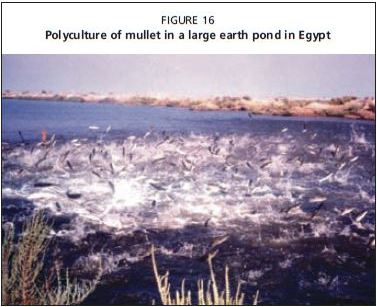AQUACULTURE DEPENDENCY ON WILD SEED
Commercial aquaculture of mullet in Egypt and other producing countries relies exclusively on wild-caught fry even though hatchery techniques have been successfully developed (Saleh, 1991; Landoli, 2000; Yeh, 1998; Sadek and Mires, 2000; Suloma and Ogata, 2006). The high cost of hatchery-produced seed compared to wild fry, and the interest of most commercial hatcheries to produce seed of higher valued marine species (e.g. European seabass and/or Gilthead seabream), are the main reasons for continued reliance on wild seed.
Fishing wild fry for aquaculture has always been a matter of debate between environmental groups, capture-fisheries communities and fish farmers. The increasing rate of seed collection in the mid-1990s was considered as a major threat to the capture fisheries. Artisanal fishing cooperatives organized extensive campaigns against wild seed collectors. This legal practice was also considered as an unjustified government policy in support of wealthy fish farmers at the expense of the larger, poorer fishing community. Environment groups believe that wild seed collection will reduce stock recruitment even though the authority claimed that the number of collected fry will have a negligible effect to the wild mullet population. The argument is based on the fact that mullet are characterized by a very high fecundity, which means that the number of collected fry for aquaculture is a very small fraction of the seeds produced by these fish. It is also claimed that the fry losses for aquaculture are considerably less than that from natural predation. This debate is not yet settled, but the stability of mullet fisheries over more than a decade in spite of a growing aquaculture industry has reduced the level of opposition even though the capability of the wild resources to cover the future growth of the sector is unknown due to limited scientific data.
Hatchery-produced mullet seed are not likely to become available in the near future in Egypt and aquaculture will continue to rely on wild seed. The cost of hatchery seed in Egypt was found to be very near or even sometimes higher than that
for other locally cultured marine species such as the Gilthead seabream, European seabass, meager and shrimp. As a result, unless a total effective ban on wild seed collection is imposed, mullet aquaculture in Egypt will continue to depend on wild seed.
FISH FEED
The success of mullet aquaculture is also a result of its feeding habits. Mullet are usually farmed in polyculture with other fish species in earthen ponds. Enhancing natural food production in the ponds through artificial fertilization is important as this reduces
Figure 16
Polyculture of mullet in a large earth pond in Egypt

considerably the requirements for manufactured feed. In the Egyptian polyculture system, natural food covers 25–50 percent of the food requirement of the cultured fish (tilapia, carps) while the farmed mullet depend totally or to a very large extent on natural food (Figure 16). Cultured mullet are sometimes supplied with wheat or rice bran during the late nursery stage or when cultured as the main component of the fish stocks.
The fish feed industry is well developed in Egypt where more than 450 000 tonnes of different forms of formulated feed (mostly extruded pellets and powder mixes) are produced annually (GAFRD, 2006). Chicken manure is also used successfully as feed for mullet in nursery and on-growing ponds.